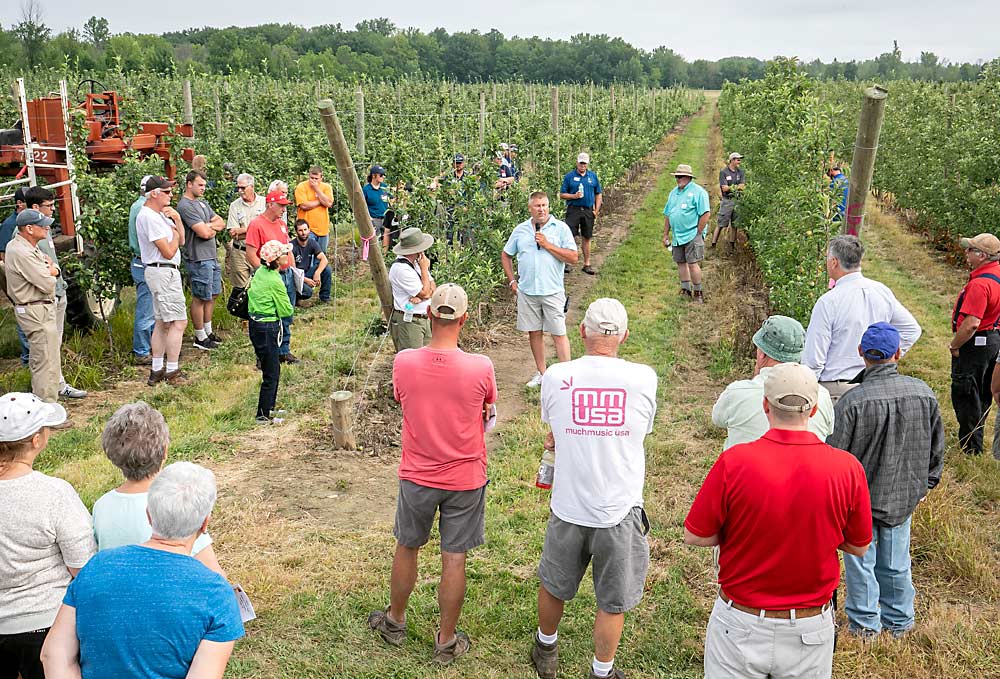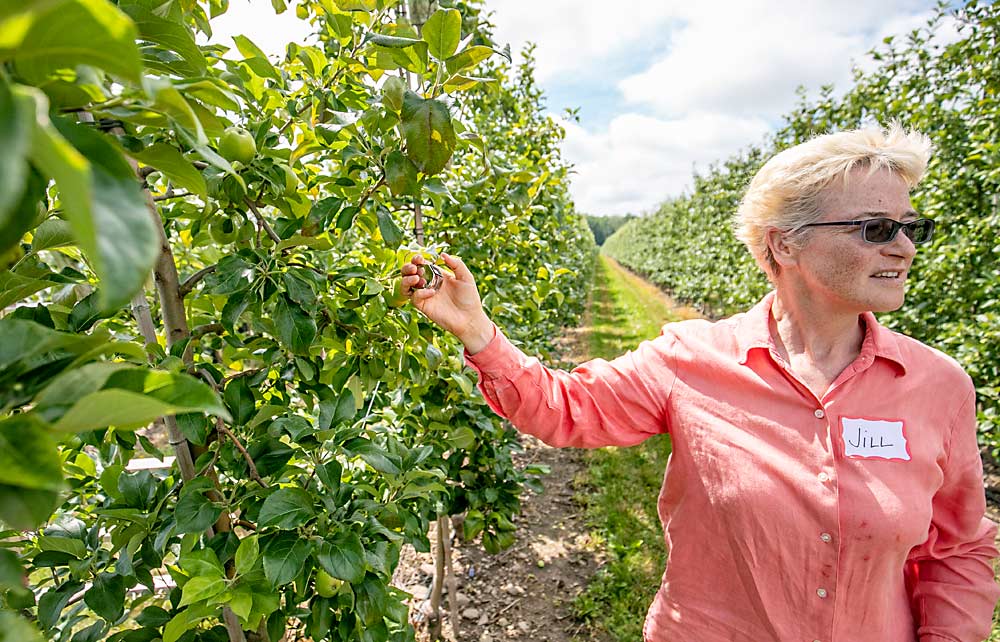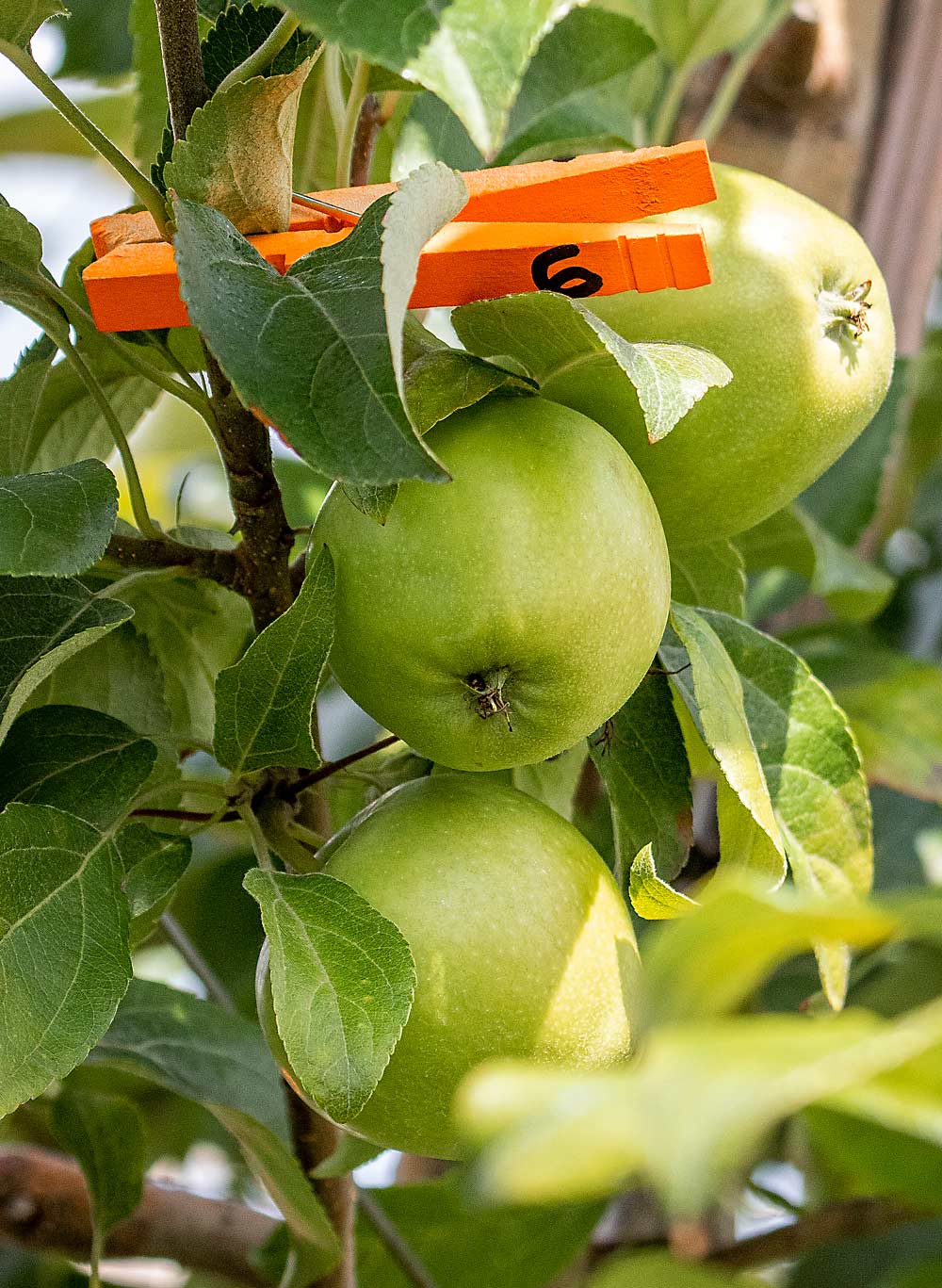
In the hope of growing larger Galas, New York grower David Tower decided to try out blossom thinning. It’s rarely practiced in the region, but he collaborated with Cornell University research and extension staff who believe it can help growers bolster Gala and Honeycrisp returns.
“I don’t want to base a decision on one year of data, but I was very happy with my Gala size,” he said.
Researchers want Tower to share his experience with others, as they urge growers to increasingly prioritize precision crop load management. The topic was a focus of the Lake Ontario Winter Fruit School in February as well, including talks on pruning, thinning, minimizing biennial bearing and bitter pit, and using the pollen tube growth model to guide bloom thinning. And Tower discussed getting the crop load he wanted — with no hand thinning needed — at the Lake Ontario Fruit’s summer tour last July.
“I’m convinced blossom thinning has a role for us in New York,” Cornell physiologist Terence Robinson said at the field day. Thinning at bloom boosts Gala size and reduces biennial bearing in Honeycrisp, he said.
In 2020, “almost all the Honeycrisp blocks are going to be heavy, and I’m trying to gear you up to do something about it,” Robinson said. “If you don’t spray something at bloom, you’ll have biennial bearing and you’ll always be kicking yourself the next year.”
Lime sulfur and oil, the common bloom thinning product used in Washington, isn’t yet registered for that use in New York, but ammonium thiosulfate, ATS, works well.
“ATS is safer for fruit finish in our humid climate,” Robinson said at the field day, although lime sulfur is more effective at killing the pollen tubes further into development, which means that ATS needs to be sprayed slightly earlier on the pollen tube growth model clock offered on Cornell’s Network for Environment and Weather Applications, NEWA.
“Overall, I’m very happy with the thinning job,” Tower said of thinning with ATS. He plans to do it again this season on Gala and Honeycrisp. “It takes a big leap of faith though, because if you knock them all off, you don’t get them back.”
The Tower trial
Tower opted to blossom thin a 2-acre block of Gale Gala planted on Budagovsky 9 rootstocks and worked with extension specialist Craig Kahlke to develop a precision crop load plan. He started with determining the target fruit size and count per tree, which they set at 88 size fruit and 126–135 fruit per tree, Kahlke said in a follow-up interview.
“You need large Gala to make any money,” he said.
They picked five representative trees, which can be tricky in a variable block, and started counting flower buds in early May. The goal: 225 flower buds. Instead, they found most of the trees had two or three times that, Kahlke said.
“He had a really good pruner, but he didn’t count. Nobody wants to count,” he said. “If you start with numbers like this — three, four, five or even six times your target — you will never be able to thin it chemically and get it close to your range.”
So, Tower brought in another pruning crew about a week before bloom. Subsequent flower bud counts ranged from 127 to 184.
The pollen tube growth model works by estimating how long — based on weather conditions — it will take a pollen tube to grow and fertilize the ovule. That means the pollen tube clock starts when the target number of king bloom flowers are open.
In Tower’s case, that occurred May 23at 5 p.m. Four days later, at 1 p.m. on May 27, the model predicted 85 percent of the king bloom had set, so Kahlke told Tower to spray on the ATS. Then, he repeated with another spray on May 30 to prevent set of the lateral bloom.
Tower followed the blossom thinning with a Sevin (carbaryl) spray at petal fall, but he didn’t need any additional thinning and the trees ended up in the crop load range he wanted.
“Many of our growers bank on that 8–12 millimeter spray, but if you have unfavorable conditions or too many fruit, it can lead to brutally high hand thinning bills,” Kahlke said. “To have the thinning job done by then and not have to worry is a relief.”
But, he cautioned that blossom thinning doesn’t replace the need for tracking fruitlet growth. “It’s going to be part of a multipronged approach for managing crop load in Honeycrisp and other high-value varieties,” he said.
Precision in practice

Many growers remain hesitant to spend the time counting buds and measuring fruitlet growth, but the Malusim app Cornell released in 2019 eases use of the fruitlet growth model, Kahlke said. Instead of one person taking measurements and another recording, followed by data entry back in the office, later, one person can talk to the app as data is collected.
Growers who have embraced the model often find their own strategies for making it more efficient. At another stop on the Lake Ontario Fruit summer tour, grower Jill MacKenzie shared her method for managing the data collection: clothespins, spray-painted orange and numbered, rather than flagging tape to mark the clusters.
She selects and flags the same pattern of five trees in every block, “just to make yourself less crazy,” she said. After she counts the clusters with a clicker, she marks 15 with the aforementioned clothespins, using the same placement pattern in every tree — numbers one to seven above the 6-foot wire and numbers eight to 15 along the side of the ladder. That way, when she comes back to collect the data, the motions are routine and much faster.

“This year, we really worked the program,” MacKenzie said. They had an average of 155 clusters per tree but wanted 75 fruit. The model data helped them “nibble” off fruit with their thinning program. They stopped thinning when the app predicted 93 and the crop on the trees looked pretty good.
“We really need those measurements to know if we are going to get the drop,” Kahlke said. The model assumes any fruitlets growing 50 percent less than the biggest fruitlets will probably drop.
Extension staff across the East have been promoting the fruitlet growth model for several years now, along with the carbohydrate model that offers insight into how the weather conditions should impact thinner effectiveness, but Kahlke said New York research and extension plans to push growers to deploy these strategies this season, from pruning on.
“Look, this is a lot of money that you are leaving on the table if you don’t precision-manage Honeycrisp,” he said. •
—by Kate Prengaman
Related:
—Eastern growers exploring an early start for blossom thinning






Leave A Comment